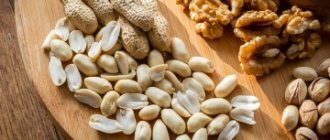Sage is one of the most popular folk remedies, recommended for stopping lactation. The medicinal plant does not grow naturally in Russia. Sage is found in warm Far Eastern countries, so it was not originally designed for cold winters. The plant is cultivated in an artificial environment in the Crimea and Krasnodar region. Proper use of sage promotes easy and safe cessation of lactation.
Sage tea
To reduce lactation, use sage herb. An infusion is prepared from dry leaves. For this, 1 tsp. crushed sage herb is poured into 250 ml of boiling water and left to infuse for 1 hour. Then the product is filtered. You need to drink 1/4 cup of sage 5-6 times a day immediately before meals. It is advisable to brew a fresh portion of the infusion daily, since its effectiveness decreases during storage.
You can use sage herb bags to prepare an infusion. Brew 1-2 sachets in a glass of hot water and leave for 5 minutes. The number of sachets depends on the required concentration. To improve the taste, you can add honey to the infusion. Take the product 50 ml 4 times a day.
To speed up the completion of lactation, prepare an infusion from the following herbal ingredients: 1 tbsp. l. hop cones, 1 tsp. sage and walnut leaves. The ingredients are poured into 2 cups of boiling water and left to steep in a warm place for 1-1.5 hours, wrapping the container in a towel. Drink the finished product 50 ml 3-4 times a day.
To get a more rich remedy from sage to suppress lactation, prepare a decoction instead of an infusion. To do this, pour 1 tbsp. l. dried herbs 0.5 liters of boiling water and keep for 10 minutes in a water bath. The broth is infused in a warm place for 30 minutes. The product prepared in this way will be more concentrated than the infusion. You need to drink it 1-2 tbsp. l. 4 times a day.
Sage during breastfeeding is a proven and effective remedy for reducing lactation
You can take dry sage leaves to stop lactation by adding them to food or drink in crushed form. To do this, the leaves are crushed and added to food or drinks, 1/4 tsp. 3 times a day. The volume of breast milk will decrease within 2-3 days.
You can buy sage at the pharmacy in the form of capsules or tablets. Instructions are included with them. It is important to adhere to the recommended doses while taking the drug and monitor the general condition of the body. During lactation, sage promotes a gradual reduction in milk production, due to which the completion of breastfeeding occurs painlessly.
When to use sage to stop lactation
Sage is recommended to be used only during complex therapy. It depends on whether it will be possible to complete the production of breast milk without pain and discomfort.
It is recommended to take into account the following aspects to safely stop lactation:
- It is recommended to regularly empty the breasts of existing milk using 1 – 2 feedings per day or pumping;
- You should regularly drink a decoction or infusion, use sage oil;
- It is undesirable to combine folk remedies, so you first need to decide on the appropriate type of product.
Sage improves the condition of a young mother. This is facilitated by the beneficial composition and the presence of antibacterial properties.
Important! Sage oil is not able to immediately stop lactation. Effectiveness will be noted only with regular use of the product.
To guarantee success, you should pay attention to additional recommendations:
- Proper pumping is still recommended on a regular basis. It usually takes a few hours or a whole day for your breasts to fill up. Hot flashes most often occur in the evening, so you should limit the amount of fluid you drink before bed. Full pumping is prohibited, as this increases the production of breast milk.
- At the final stage of breastfeeding, the mammary glands should not be ligated. Rigid fixation threatens stagnation and mastitis.
- Using cold compresses will relieve discomfort in the chest, eliminate the feeling of swelling and painful syndrome. As a result, the woman experiences a general improvement in her health.
The entire cycle of events will take from one to two weeks. Usually this period is enough to stop breast milk production. Sage is most often advised to drink within one week. It is important to be prepared for the fact that the exact period for measures to stop lactation is determined by the presence or absence of congestion, so sometimes taking sage and pumping are briefly extended.
Sage is a unique medicinal plant that provides comprehensive support to the female body. Despite this, contraindications still exist.
Sage should not be used for the following diseases:
- polycystic ovary syndrome;
- jades;
- endometriosis;
- uterine fibroids;
- hypothyroidism;
- diseases of the nervous system.
Ideally, before using sage to stop lactation, you should consult a doctor to determine the potential benefits and side effects of the medicinal plant.
Essential oil
Sage oil is a natural remedy that contains biologically active substances in large quantities. It is characterized by a faster action in comparison with a decoction or tincture of sage. This oil can be used for compresses on the chest during lactation. To do this, add 2-3 drops of sage oil to 25 ml of vegetable oil, moisten gauze pads with this mixture, place them on both mammary glands and leave for 40-60 minutes. It is recommended to do such compresses several times throughout the day.
Sage oil, intended for food purposes, is taken orally 5-6 drops 4 times a day. The use of this product helps reduce the amount of milk and helps complete lactation in a shorter time.
Important tips for stopping breastfeeding
The need to stop lactation arises for various reasons: the mother’s health, the child’s refusal to breastfeed, etc. Pediatricians advise feeding a newborn with breast milk for at least 1 year.
The process of completing lactation can cause some problems, so you should listen to the recommendations:
- Weaning does not break the close relationship between mother and child. There comes a point when milk is replaced with vitamins and nutrients from other foods.
- A process initiated by the mother may be difficult for the child to perceive. It will take a lot of patience and time before the child's body gets used to the changes.
- Do not suddenly stop feeding. Gradually reducing the number of times your baby latches to the breast will benefit both of you. It is not recommended to bandage the breasts, as such actions can cause mastitis. To relieve discomfort, apply a cold compress or ice. You can express a small amount of milk if your breasts are very full. It is important not to provoke new milk production by such actions.
- It is recommended to skip 1 feeding and offer the baby to drink expressed milk from a bottle. You can also use a sippy cup or small cup.
- The baby can ask for the breast without feeling hungry. It is recommended to distract his attention with games or a walk.
- Breastfeeding mothers sometimes give breastfeeding to their baby, wanting to soothe him. You can improve your newborn's mood in other ways (hug, read a book, sing a song).
- To reduce the time. If the baby is attached to the breast for 5 minutes, stop feeding after 3 minutes. You can offer permitted fruit as a snack.
- The child drinks little, and the amount of milk does not decrease. In this case, it is recommended to reduce the amount of liquid consumed to a minimum. You should not take too hot a shower. To reduce pain, it is recommended to apply chilled cabbage leaves to the chest.
- You should teach your child to fall asleep while eating. After lunch, you can take a walk outside so that your newborn learns to fall asleep on his own. When putting your child to bed in the evening, you can turn on slow music, read a fairy tale, and put your favorite toys in bed. After some time, the newborn will get used to the new ritual.
- Wean your child off night snacks and set him up for uninterrupted sleep. If he wakes up at night, you should not give him the breast. It is best to rock the baby in your arms and sing a lullaby. You can offer to drink water.
- Once you are determined to stop lactation, you cannot give up when you hear a baby crying. It is recommended to be close to the child and try to comfort him. The mother's confidence and calmness are transferred to the child.
The child may not be ready for drastic changes. You should not start this process if the newborn is sick. If there is no urgent need, weaning can be postponed for a while.
We recommend that you read: Sage help for coughs
Alcohol tincture
A contraindication to using the tincture during breastfeeding is the presence of alcohol in it. It can be taken if the baby is not put to the breast. Dissolve 50 drops of tincture in a small amount of liquid and drink 4 times a day.
Sage to reduce lactation is a safe natural remedy. When choosing a dosage form, we are guided by the following principles:
- To gradually reduce milk production during breastfeeding, when the baby continues to be breastfed, preference is given to a less concentrated product. An infusion or decoction is suitable for this.
- To ensure that lactation ends in a short time, choose sage oil, extract or alcohol tincture. These drugs are quickly absorbed by the body and are effective.
Contraindications
Contraindications for stopping lactation with sage:
- epilepsy;
- pyelonephritis;
- high blood pressure;
- pregnancy period;
- individual intolerance.
Before taking sage to stop lactation, consult a specialist. Sometimes taking plant-based drinks provokes adverse reactions, for example, dizziness, nausea, and stomach pain. If these symptoms occur, stop taking the medication and consult a doctor.
Precautionary measures
Contraindications to the use of sage-based products are the following diseases:
- epilepsy;
- acute inflammatory kidney diseases;
- endometriosis;
- tumors of the mammary glands or uterus;
- endometrial hyperplasia;
- hypofunction of the thyroid gland.
They should also not be used in case of individual intolerance and pregnancy. If there are contraindications, another drug is selected to stop lactation. Before starting to take the medicine, you should consult a doctor.
It is not recommended to abruptly stop breastfeeding.
Sage during breastfeeding is a proven and effective remedy that reduces lactation. It has been proven that it does not affect the properties and composition of breast milk, therefore it is absolutely safe for the baby. It is recommended to take it for no more than 3 months, since long-term use in large doses can lead to poisoning of the body.
Negative effects of sage on the body
First of all, it is worth saying that as soon as a mother decides to drink sage in order to complete natural feeding, it is worth excluding possible supplementary feeding of the baby with breast milk. The fact is that there are no studies explaining the effect of such milk on the child’s body and health, and there is no point in experimenting on the health of your loved one. The famous children's pediatrician Komarovsky also opposes such actions.
Based on reviews on online forums, we can conclude that you should not use sage as a remedy for a long time, as this can provoke the development of vomiting, bloating, cause nervous agitation, or, conversely, lead to a state of depression. Therefore, it is important to listen to yourself and give up sage in time if such symptoms are detected.











